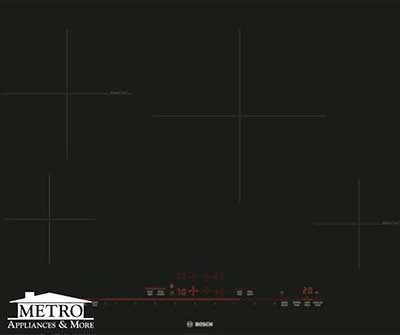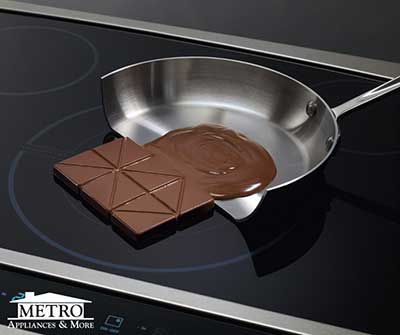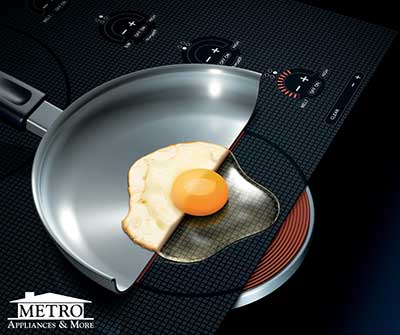Cook Smarter Not Harder
Tue Jun 23 2020
What Is Induction Cooking
First, let’s define induction cooking. Induction cooking heats pots and pans directly, rather than relying on an electric or gas-heated element. Since you don’t have to wait for a burner to heat up before heating up your induction pan, you can boil water up to fifty percent faster with the induction heating method, all the while maintaining a precise, consistent temperature. As an added bonus, the actual surface remains relatively cool, making the clean-up of the occasional splatter, spill, or boil-over easy peasy.

How Induction Cooking Works
In short: magnets.
Magnetic induction is used to channel electric currents to directly heat pots and pans. This eliminates the transference of heat we’re all familiar with through thermal conduction, which heats a burner that is then used to heat something else. Instead, we put the heat right where we want it—on the thing that’s going to be doing the cooking.
Now what’s the science of it? Magnetic induction is created when an electric current passes through a coiled copper wire from under the cooking surface. Without a traditional outside heat source, the only thing to be heated up is the pan itself. There is very little heat energy lost in this transaction, which makes it more efficient than electric or gas cooking methods. Then our old friends, conduction and convection, do the rest, evenly heating pots and pans.
But remember, this is all possible through magnets. In order for induction cooking to work, you need to make sure your pot or pan is magnetic. Cast iron is your friend in this, and some stainless steels. If you’re uncertain whether or not your cooking vessels are up to the task, just try to stick a magnet on them. If it sticks, you’re golden. If not, time to invest in new cookware.

When we say the pan is hot but the surface is not, we mean it. As pictured above, you can enjoy solid chocolate while melting chocolate from the same bar.
Advantages to Induction Cooking
We’ve gone over what induction cooking is and how it works. The question you may be asking yourself now is: “What’s in it for me? Why should I upgrade my appliances to allow for induction cooking?”
One of the major draws is something we’ve mentioned already—energy efficiency. Not only do these cooktops help you shrink your carbon footprint, but this translates to savings on your energy bill. But if that isn’t enough to sway you, here are a few additional reasons why it might be time to make the switch.
1. It boils water up to 50% faster
We mentioned this above, but it deserves a repeat. There is no waste of heat in induction cooking, since we’re heating the cookware directly and not through a burner.
2. Temperature control
Induction allows more control over heating than conduction (the old fashioned way). As a result, you lower the risk of over or undercooking.
3. Easy-to-clean surface
Like your typical electric cooktop, an induction appliance has a smooth surface. And you’re finished cooking, the surface will cool almost instantly, so you can clean up any spills right away.

Pictured above: another example of how induction cooking literally only heats the cooking device.
So, faster cooking, energy-saving, reduced clean-up time. Cook smarter, not harder.
Metro Appliances & More has a variety of induction cookware, from Frigidaire (and shout out to them for their induction tips) to many, many other brands. Additionally, you can upgrade a standard range with an induction cooktop surface, or replace your range completely with a freestanding induction range. Call or visit your local Metro Appliances & More to learn more about induction cooking appliances.
Welcome to our website! As we have the ability to list over one million items on our website (our selection changes all of the time), it is not feasible for a company our size to record and playback the descriptions on every item on our website. However, if you are an American with a disability we are here to help you. Please call our disability services phone line at (918) 622-7692 during regular business hours and one of our kind and friendly personal shoppers will help you navigate through our website, help conduct advanced searches, help you choose the item you are looking for with the specifications you are seeking, read you the specifications of any item and consult with you about the products themselves. There is no charge for the help of this personal shopper for any American with a disability. Finally, your personal shopper will explain our Privacy Policy and Terms of Service, and help you place an order if you so desire.
Copyright © 2009 - 2023 Metro Appliances & More | Kitchen & Home Appliance Stores All Rights Reserved.
Copyright © 2009 - 2025 Company All Rights Reserved.
This site is protected by reCAPTCHA and the Google Privacy Policy and Terms of Service apply.
